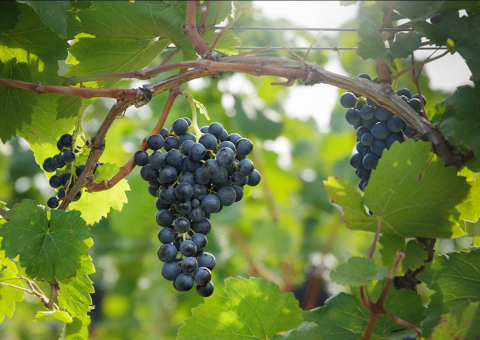Wine experts and journalists from all four corners of the world travelled to the alpine village of Lech – a haven for gourmets – to analyse the Blaufränkisch variety in a one-day workshop and to define its potential in the international fine wine market.
Unanimously recognised
Let’s start with the key facts. Blaufränkisch is unanimously recognised as one of the world’s great red wine grape varieties because it ticks all the right boxes in terms of what we expect of an outstanding red wine, such as ageing potential, the expression of its terroir, complexity, distinctiveness and finesse.
After tasting more than 50 of the best Blaufränkisch wines from the 1986 to the 2020 vintages, produced by 17 different winegrowers, the jury panel decided on the following varietal description: “Freshness and acidity combined with a precise fruitiness and tightly woven body. The aromas correspond to those of dark berries, together with a smoky spiciness and notes of dried herbs.”
David Schildknecht (Vinous, USA) added: “What makes Blaufränkisch so special is a freshness and vibrancy that you usually only find in white wines.”
What the jury panel repeatedly confirmed throughout the tasting is the skilful way in which Blaufränkisch expresses its origin without the variety itself taking up too much room. According to Sascha Speicher (Meininger’s Sommelier magazine, Germany), “A great wine should primarily demonstrate its terroir. If the first thing I notice is the grape variety, it’s not a great wine.” Harald Scholl (Vinum magazine, Switzerland) backed this up: “Historically great wines have always been defined by their origin and appellation, never by their grape variety.”
Freshness, expressed through the wine’s vertical structure
Blaufränkisch also benefits considerably from its distinctive acidity, which can give the wine a high degree of freshness and finesse. As René Langdahl from Denmark explained: “Nowadays, freshness is the key characteristic that enables us to classify a wine as great. This was not the case thirty years ago when grapes didn’t often reach full ripeness. In many wine-growing regions, wineries face the problem of producing overly fat wines. Blaufränkisch, on the other hand, is still able to display this freshness even in hot, very dry years – a freshness that is expressed through the wine’s vertical structure and its unique, fine bitterness.”
Producers are continually learning
In general, experts are advising winegrowers against producing powerful, over-extracted and wood-heavy wines. “We are currently seeing a significant move away from over-ripe wines,” explained Jamie Goode (wineanorak, UK), describing the development of the international wine sector. “Producers are continually learning how best to work the vines to ensure perfect ripeness without ending up with excessive gradation. We are living in very interesting times – perfect for Blaufränkisch to show us what it’s made of.”
To sum things up, Goode pointed out: “If you make a wine with 15% alcohol, using a lot of new oak, it doesn’t matter which variety you use – the end result will still be s***.”
Great ageing potential
The experts also paid particular attention to another characteristic used for defining a great grape variety – its ageing potential. “I have never drunk a Blaufränkisch that tasted better during the first ten years of its life than it did when it was older,” added Clemens Riedl from trinkreif, one of the event organisers. “Blaufränkisch simply needs ten years to develop, especially when it comes to single-vineyard wines.”
Winemakers need to work to the highest standards if they want their Blaufränkisch wines to be rich in finesse, display typicity of origin and have a good ageing potential. This begins in the vineyard, where the yield needs to be significantly restricted in order to produce first-class wines. Many wineries are already aware of this, which leads to the overall high quality of Austrian reds. According to David Schildknecht, Austria has seen a new self-confidence emerging with many believing that specific wine styles – such as those produced from Blaufränkisch – can only be produced in Austria. “There is a clear trend moving away from ‘We can do that, too!’ towards ‘Only we can do that!’”
The Blaufränkisch Summit was a joint initiative run by trinkreif, Lechzürs Tourismus, Hotel Almhof Schneider and supported by the Austrian Wine Marketing Board. The event was attended by:
Marc Almert, the “World’s Best Sommelier”, Baur au Lac, Switzerland
Willi Balanjuk, wine journalist, A la Carte, Austria
Philipp Braun, food journalist, Oberösterreichische Nachrichten, Austria
Ivan Carvalho, food journalist, Monocle, Italy
Sara Døscher, wine journalist, VG, Norway
Romana Echensperger MW, wine writer, Germany
Roland Graf, wine journalist, Falstaff, Austria
Joshua Greene, wine journalist, Wine & Spirits, USA
Jamie Goode, wine journalist, wineanorak.com, UK
René Langdahl, wine journalist, renelangdahl.com, Denmark
Linda Perez, wine journalist, Svenska Dabladet, Sweden
Stephan Reinhardt, wine journalist, Robert Parker Wine Advocate, USA
Jancis Robinson, wine journalist, Financial Times, UK
David Schildknecht, wine journalist, vinous.com, USA
Jürgen Schmücking, food journalist, GaultMillau, Austria
Harald Scholl, food journalist, Vinum, Switzerland
Sascha Speicher, wine journalist, Meininger Sommelier magazine, Germany
Gabby Stone, wine journalist, Drinks Business, UK
Pauline Vicard, wine analyst, Areni, UK
Elena Rameder, sommelière, trinkreif, Austria
Roland Velich, winegrower, Austria
Clemens Riedl, wine merchant, trinkreif, Austria
The event was also attended by the following sommeliers and sommelières from restaurants in Lech Zürs:
Josef Neulinger (Almhof Schneider), Anna Kleinle (Arlberg), Martin Prodinger (Sandhof), Markus Winkler (Aurelio) and Günther Meindl (Berghof).








